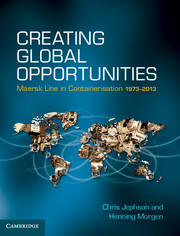Book contents
- Frontmatter
- Dedication
- Contents
- List of figures
- List of tables
- List of Economist Intelligence Unit data
- List of boxes
- Acknowledgements
- Glossary
- Prologue
- 1 ‘Per Aspera Ad Astra’
- 2 The Coming Revolution
- 3 The Decision
- 4 Building the Base (1978–1984)
- 5 Planning the Next Steps (1984–1987)
- 6 Laying the Foundations for Expansion (1987–1990)
- 7 The 1990s
- 8 The Acquisition Trail (1992–1998)
- 9 1999 A Year of Developments and Acquisitions
- 10 Into the New Millennium (2000–2005)
- 11 P&O NedLloyd (2005–2007)
- 12 A New Strategy (2008–2013)
- Epilogue
- Notes and References
- Index
5 - Planning the Next Steps (1984–1987)
Published online by Cambridge University Press: 05 April 2014
- Frontmatter
- Dedication
- Contents
- List of figures
- List of tables
- List of Economist Intelligence Unit data
- List of boxes
- Acknowledgements
- Glossary
- Prologue
- 1 ‘Per Aspera Ad Astra’
- 2 The Coming Revolution
- 3 The Decision
- 4 Building the Base (1978–1984)
- 5 Planning the Next Steps (1984–1987)
- 6 Laying the Foundations for Expansion (1987–1990)
- 7 The 1990s
- 8 The Acquisition Trail (1992–1998)
- 9 1999 A Year of Developments and Acquisitions
- 10 Into the New Millennium (2000–2005)
- 11 P&O NedLloyd (2005–2007)
- 12 A New Strategy (2008–2013)
- Epilogue
- Notes and References
- Index
Summary
Containerisation has certainly been the clear catalyst or boost to globalisation. There is no question – to put it bluntly – that it has been a major contributing factor to the rapid growth of world trade . . . producing the same impact on transportation that fibre optics has had on the telecommunications industry, for example.
Nariman Behravesh, Chief Economist, Global InsightThe Global Steering Committee
The mid 1980s saw a number of significant developments and innovations within Maersk, particularly in the use of information technology, but also in respect of the FEFC and its rights structure, as well as in Maersk Line’s approach to other trades. Although these did not necessarily materialise in a long series of record-breaking ships, they did result in a developmental blueprint for the business for much of the next ten years. A key driver was the challenge Ib Kruse set the global management team – to double the size of the business over a five-year period.
In November 1983, after a general business review, a new Global Steering Committee was established. Comprising Per Jørgensen (Asia), Ted Ruhly (United States), Karsten Borch (London) and chaired by Ib Kruse, the objective being to tap into the expertise and ideas that the new, stronger, locally based organisations in the 19 country offices were able to provide. These offices, which were close to the customers, were at a point where their knowledge and expertise meant more involvement would be sought from them.
- Type
- Chapter
- Information
- Creating Global OpportunitiesMaersk Line in Containerisation 1973–2013, pp. 124 - 159Publisher: Cambridge University PressPrint publication year: 2014



